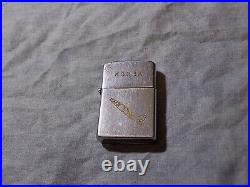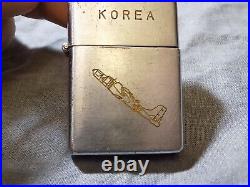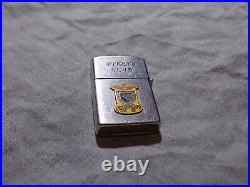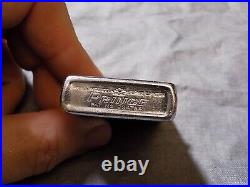1 each, KOREAN WAR B26 Invader PRINCE lighter 3rd Wing NON SOLUM ARMIS





You get 1, Uno, Bir, Ichi, Ein.. As seen lid is a little loose and the lid spring is missing. 3rd Wing Korean war info from wiki... Broke out in June 1950, the 3rd Wing participated from the first bombing sortie to the very last during the Korean War. The 8th Bombardment Squadron, staging from Iwakuni Air Base.
On the west coast of Japan, flew the first Air Force mission of the war on 27 June. The squadron struck North Korean ground forces, destroying several tanks and vehicles. Later that day, the 13th Bombardment Squadron attacked the tank column again. Bad weather prevented further attacks for the next two days. The first Americans to lose their lives during the Korean War, First Lieutenant Remer L.
Harding and Staff Sergeant William Goodwin, were assigned to the 13th Bomb Squadron, 3rd Bombardment Wing when they died 28 June 1950 returning from a sortie on the Korean Peninsula. President Truman, on 30 June, authorized the Air Force to strike targets in North Korea and, in another first, the 3rd Bombardment Wing launched 16 B-26 Invaders. From the 8th and 13th Bombardment Squadrons against Pyongyang Airfield.
The same day, destroying 25 North Korean aircraft on the ground and damaging another 20. Sergeant Nyle Mickly scored the first aerial victory over North Korea by shooting down a fighter. A 3rd Bombardment Group (Light) B-26 Invader. Conducts a rocket attack on the rail yard at Iri. In early September 1950 as part of deception operations to draw enemy attention away from the planned amphibious landings.
On 1 July 1950, the 3rd Bombardment Group moved to Iwakuni Air Base. Japan, where it could be closer to its targets. The wing headquarters remained at Yokota until 1 December 1950, when it joined the group.
Initially, the 3rd Bombardment Group operated under the operational control of Fifth Air Force. Control reverted to the wing headquarters on 1 December 1950.
The group continued to strike targets in North Korea and fly low-level attacks against advancing North Korean columns. By the end of July, the North Koreans had been forced to stay off the roads during daylight hours. The group switched to night missions in August 1950, flying its jet-black B-26s against North Korean convoys and other targets from its base at Iwakuni.
On 15 September 1950, General MacArthur. Conducted his surprise landing at Incheon. With the ensuing Battle of Inchon. Cutting off the North Koreans in the south and shifting the initiative to the United Nations forces. The 731st Bombardment Squadron (Light, Night Attack), a reserve unit called to active duty, joined the group's three squadron in November 1950 and remained until June 1951. Operations continued into 1951 as the defensive lines stabilized following the entry of the Chinese Communist People's Liberation Army. Into the conflict in late 1950. The 3rd Bombardment Group, then back under control of the 3rd Bombardment Wing, continued its night interdiction missions against targets in North Korea.The 3rd Bombardment Group physically rejoined its parent wing when both moved to Kunsan Air Base. (K-8), South Korea in August 1951. Odman, who had assumed command of the wing in July, had searchlights mounted on B-26s. The new illumination proved highly effective over the flares that had been used.
Was posthumously awarded the Medal of Honor. For his actions on 14 September 1951: flying a night mission in a B-26, Capt Walmsley discovered and attacked an enemy supply train, and after exhausting his ammunition, he flew at low altitude to direct other aircraft to the same objective; the train was destroyed but Walmsley's plane crashed in the target area. The 3rd Bombardment Wing continued to serve in Korea for the remainder of the war. In recognition of the wing's distinguished service, the 3rd Bombardment Wing's was granted the privilege of conducting the last bombing mission over North Korea minutes before implementation of the Korean Armistice Agreement. When the 3rd Bombardment Wing's units completed their war tour in Korea, they had racked up a record that included the first and last bombing missions of the war.
The squadrons had flown 33,220 sorties, destroyed 31,026 vehicles, 337 locomotives, 2,920 boxcars, 116 bridges, and 529 buildings, and cut 918 roads and 841 rail lines. #2 If it isn't listed. Don't ask about it. This is a waste of both our time.#3 Do not "demand" special treatment. I generally go out of my way to make things right if I make a mistake or things go wrong. #5 Understand that these rules are here because of issues I have had with buyers in the past. If these rules upset you. That is the best course for both of us.
